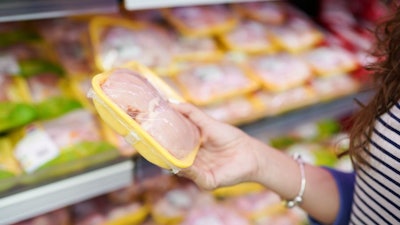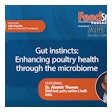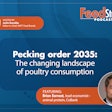
Chris DuBois, senior vice president, Americas protein practice leader at IRI, discusses how the COVID-19 pandemic may have changed the way consumers buy animal protein products.
PODCAST: Is there a new normal in consumer protein-buying trends? (09:41)
Ann Reus: Hello and welcome to the Feed Strategy podcast. I’m your host, Feed Strategy senior reporter Ann Reus. Today I’m speaking with Chris DuBois, senior vice president, Americas protein practice leader at IRI. IRI is a data analytics and market research company that provides market intelligence and analysis focused on the consumer packaged goods, retail and health care industries.
Chris spoke January 25 at the Feed Strategy Conference during the International Production & Processing Expo in Atlanta, where talked about the new normal in consumer animal protein buying trends.
Hi Chris, welcome to the podcast.
DuBois: Thanks a lot, Ann. It’s a pleasure to be here.
Reus: Can you tell me a little bit about what you discussed during the Feed Strategy Conference?
DuBois: Yeah, it was a great talk. And I appreciate all the input from the audience and the great questions. One of the things I started off with was a recap of some of the big trends that I see coming forth out of the pandemic that I see lasting for the next three to five years. These are fundamental changes in consumer buying behavior, purchase behavior. And they’ve gained strength throughout the whole pandemic, but what we’re seeing now is not only acceleration, but just continued growth. And the companies that get behind these big trends and understand them grow faster than the ones that don’t. So it’s an exciting time in the poultry and protein worlds.
Reus: Can you talk about one trend in particular that has emerged from the COVID-19 pandemic that you feel is here to stay?
DuBois: Well, there is one big fundamental change that happened, that kicks off all the rest of the trends, or at least most of them. And the first one is really just work from home. The fact that, back in 2017, about 7% of the population worked from home in a consistent way. Right now, we have a very elevated group, well above 30% of people are working primarily at home. What that changes is meal occasions. So, a breakfast that might have been taken on the run and eaten at the office is eaten at home. Work-from-home lunch is a huge opportunity. If you’re a consumer marketer, both from either at a retailer side or a manufacturer side, that work-at-home lunch is the single biggest meal occasion change that we’ve seen in the last three decades. So, the companies that can innovate, that understand those situations, are really thriving, and we’re seeing a whole host of new products coming through. But what that changes too is that combination then, of when people are at home, there’s time to plan dinner. And what we saw through the pandemic was a major change in cooking behavior. You and I and everybody else, everybody cooked more, we all cooked, more meals were made at home. But there’s 30% of the U.S. that drastically changed the number of proteins that they bought, and drove almost all the growth in the meat case. They cook very differently. They wanted to experiment, they tried new cuts, they tried new proteins. And that kind of experimentation created a confidence in cooking. And that’s why we call that group the confident cooks. That 30% of people drove 97% of the meat incremental growth in 2020. And it continued into ’21. So that fundamental change in how people cook, and prepare meals, etc., is a big deal. And we’re seeing that trend, not just go down and disappear and change, but it’s continuing. And the feedback we get from consumers is they see the value from the foods that they buy at the supermarket. And now they’re creating great new occasions at home through that cooking behavior. But it’s not everybody. It’s about 30%.
Reus: Yeah, yeah, I can relate. What’s another trend that you’re seeing when it comes to consumers’ animal protein buying habits that is meaningful but not necessarily related to the pandemic?
DuBois: So, I know a lot of people talk about rising prices, and that has been a big deal, you know, rising prices in the supermarket has hit a lot of people. But you know, those rising prices are out in the foodservice place too. But one of the things we’ve seen over the last two years is a big jump in people buying premium products. And it’s not just rich people buying; this is all income levels. In fact, middle incomes and lower incomes are driving more of the premium foods growth. So that willingness to pay a little bit more for a better product in a lot of categories is elevating the premium and super premium segments of a lot of the categories. So that’s why you see some of the higher-end proteins in the meat case, growing faster than others. Now it moderates off and on depending on where things are from a COVID side, etc. But that premiumization trend has been there. And when you combine that with the fact that people are cooking more, and some people are really embracing cooking, experimenting, creating new dishes and trying new things, that desire to continue to go after the premium side, we see growing for the next two to three-four years. So it’s something that’ll last well beyond whatever’s happening in January 2022.
Reus: So how are these lasting trends expected to affect the chicken supply chain, from feed to live production to processing and retail?
DuBois: Well, one of the things we highlighted here was the continued growth in no antibiotics ever as well as organic. So organic, right now, fits into what’s a premium chicken side. And right, if you think about where we were maybe six, seven years ago, organic used to be about 2% of chicken. Right now it’s six and growing. In fact, when you add up the incremental growth of no antibiotics ever and organic, those two, chicken with those traits, drove all the growth last year. In fact, more than all the growth. So the consumers continue to support and drive those categories. Organic will be niche, I don’t see it going beyond 10. But the mere fact that it continues to grow, and it’s an exception to the other proteins, which tend to be a lot smaller. Pork is about, I think, under 1%. Beef, it’s right around two. For chicken to be six, shows that consumers think about organic chicken differently than organic beef and organic pork.
Reus: Now, do you have any insight into what consumers are thinking that’s driving that trend?
DuBois: We kind of view consumers, from a lot of the work we’ve done, we’ve done an enormous amount of segmentations, based on sustainability, based on consumers beliefs and attitudes and purchase behaviors, we’ve seen a number of different angles, and they change depending on which segments you’re looking at. There’s a group of consumers that thinks about it from an environmental side, so they give a halo over to organic or some of the other traits and say, well, if chickens are raised that way, it must be better, and I want to support that. Now, whether that’s right or not, it’s kind of their belief, and they’re backing it up with the dollars. There’s also a group of people that will buy organic foods for their kids, but they may not buy it for themselves. Maybe they can’t afford it, or maybe it’s not there, but they will buy better items for their kids in that side. And then there’s some who are, there’s another group that tends to be very active, very athletic, focused heavy on convenience, but they will use organic products or certain types of products that are better for them as a way of improving their health overall. So, the lens of how people look at it can be very different depending on the groups that you’re talking to. But those are some of the big beliefs coming through.
Reus: Interesting. Now, I know that IRI collects a ton of data and information. Can you tell me how and where you get that data and who should be paying attention to it and why?
DuBois: For us, we see every item that’s sold in every store every day, in the supermarket grocery convenience, club world. So, if you can imagine the amount of data coming through IRI computers from our retail partners, that’s exactly what we’re seeing. And then it’s not only just keeping track of that item, we know hundreds of different attributes about each item. So we can turn those attributes around in our database and make it easy for people to search and understand what’s going on. And then when you combine it with 50 million frequent shopper cards and 100,000-person panel, our deep understanding of consumers gives clients unbelievable visibility into the motivations, background and beliefs of consumers to understand the why – why people are buying. So that combined with a whole host of other tools makes us one of the most valuable partners for both manufacturers and retailers in the food world.
Reus: Well, thank you, Chris for all of that great info.
DuBois: Thanks a lot, Ann. It’s a pleasure being here today.
Reus: If you missed the Feed Strategy Conference at IPPE but still want to check out all the great talks, you can view the sessions on demand at FeedStrategy.com. Thanks for listening.

















